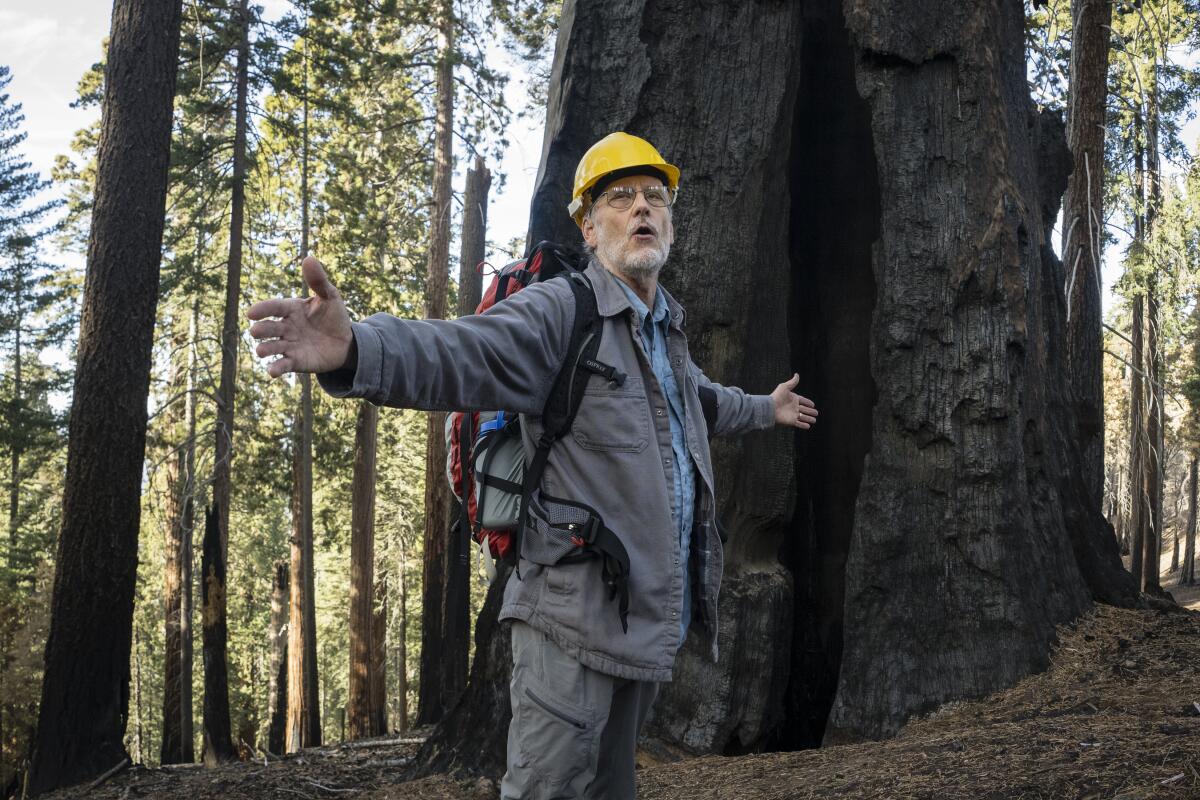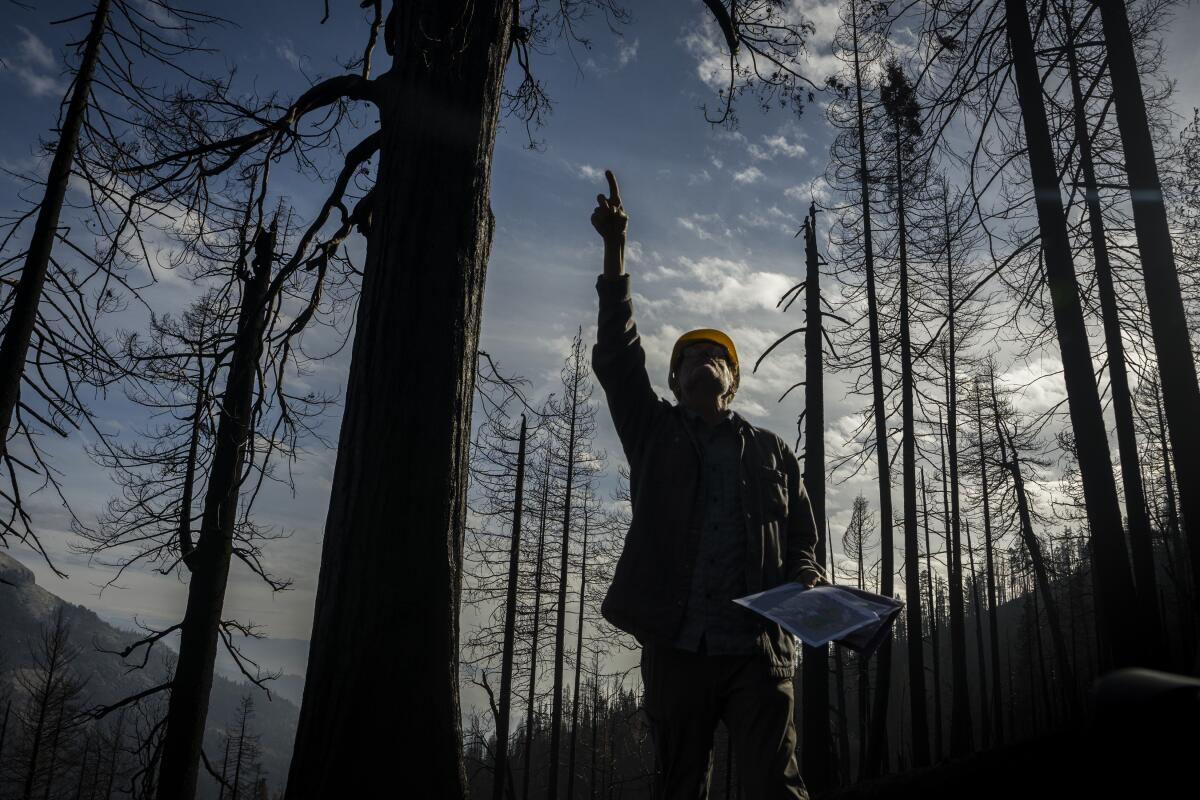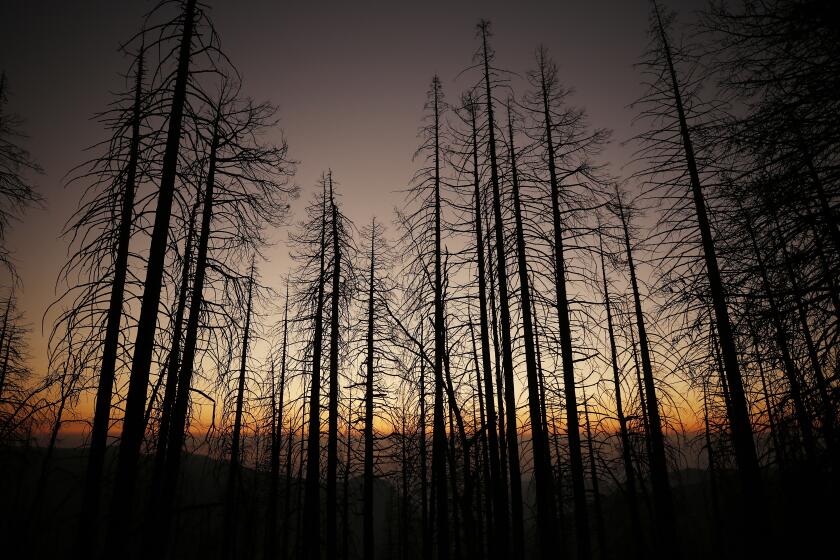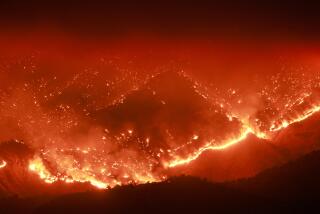Wildfires killed thousands of sequoias in southern Sierra Nevada

- Share via
As many as 3,600 giant sequoias perished in the flames of the twin wildfires that ignited during a lightning storm in early September and rampaged through 27 groves of the behemoths in the southern Sierra Nevada, National Park Service officials said Friday.
More than two dozen groves of the towering trees were scorched as the KNP Complex and Windy fires exploded through parched vegetation, exacerbated at times by fierce winds and thunderstorms.
For the record:
5:46 p.m. Nov. 19, 2021An earlier version of this article said that the General Grant Tree was swaddled in a fire-resistant aluminum blanket last month to protect it from the KNP Complex fire. The tree was not blanketed; there were sprinklers placed around it to protect it from flames.
It’s a stunning loss that equates to 3% to 5% of the world’s giant sequoia population — arriving on the heels of even greater devastation. Last year’s Castle fire killed up to 14% of the global population of giant sequoias. Among the three fires, officials estimate nearly 20% of all sequoias may have perished in the last 14 months.
The somber news was delivered at a briefing in the Grant Grove of Kings Canyon National Park, in the shadow of the General Grant Tree — considered the second largest tree on Earth. Last month, the massive tree, which rises more than 260 feet, was surrounded by sprinklers to protect it from the still-active KNP Complex fire that has torched more than 88,300 acres in rugged country in Sequoia and Kings Canyon National Parks.
“It does not ever get easy looking at a monarch giant sequoia that has died,” said Teresa Benson, supervisor for the Sequoia National Forest, at the briefing. “That is one of the hardest things that I’ve ever had to look at in my entire 30-year career with the forest service. It is not a good thing for our environment.”
Though it’s no longer a threat, the KNP — still just 75% contained — continues to chew through pockets of heavy fuel.
Meanwhile, crews have fully contained the Windy fire to the south, which burned upward of 97,500 acres in the Tule River Indian Reservation and Sequoia National Forest.

The KNP Complex scorched 16 sequoia groves, and the Windy burned 11 groves of the giant trees, natural wonders that can live more than 3,000 years and rise over 250 feet.
Among the worst was Redwood Mountain Grove, where scores of giant sequoias were torched by the KNP Complex fire.
Interspersed with healthy-looking trees, blackened sequoia carcasses rose Friday in eerie, almost sculptural forms, like an army of the dead.
Some were still smoking from the blaze that erupted more than two months ago.
Officials had steeled themselves for the devastation, though the massive trees have survived — and thrived — amid wildfires for thousands of yeas.
With their towering canopies and thick bark, giant sequoias are adapted to withstand low-intensity fire, and even need it to reproduce. But ferocious climate-change-fueled fires of recent years have proved fatal to the trees that experts once thought were impervious to flames.
Desperate to protect the giant trees, fire officials have wrapped them in foil and doused them with gel. Some methods have never been tested.
Officials on Friday said that between 2,261 and 3,637 sequoias with a base of 4 feet or more in diameter were either killed or so severely damaged that they would die in the next three to five years.
The figures come from a report based on analysis by scientists from the Nature Conservancy and the National Park Service. While preliminary, Christy Brigham, chief of resources management and science for the Sequoia and Kings Canyon parks and co-author of the report, thinks they’re accurate — or worse, an underestimate.
Discussing the number of sequoias that perished, Brigham teared up at the briefing.
“While these losses are not as stark and large as the Castle fire, they are still significant, unsustainable and are outside the range of historic fire effects on large sequoias — and are not what we are trying to achieve as we manage these magnificent forests for fire and climate change resilience,” she said.
Since 2015, high-severity fires have killed large giant sequoias “in much greater numbers than has ever been recorded,” officials with the National Park Service said. Drought has also contributed to their decline, weakening their defenses and making them susceptible to incursions from bark beetles, another scourge to which they’ve historically been immune.
The KNP Complex and Windy fires ignited Sept. 9 amid thunderstorms that roiled the region and quickly exploded amid the parched landscape. As crews struggled to battle flames raging in steep, difficult-to-access areas, a devastating revelation emerged: The flames had pushed in the direction of the famed Giant Forest, home to some 2,000 giant sequoias, including the largest tree in the world.
As the grim reality set in, crews in mid-September wrapped the hulking base of the General Sherman tree — and some other well-known giants — in aluminum material typically used to protect buildings. General Sherman, considered the largest tree by volume, and many other nearby trees survived, in part, because of decades of prescribed burns to clear out vegetation in the tourist mecca.
But prospects were dimmer for more remote, less-manicured groves.
Garrett Dickman, a botanist assigned to the Windy fire, expressed fears weeks ago that tree mortality rates could rival those of the 2020 Castle fire, which burned at least 7,500 trees.
Aided by a sequoia task force, Dickman trekked through the backcountry to prepare trees for fire when possible and treat them after flames had passed through. He saw heavily scorched trees and entire groves he estimated had been decimated.
As the crews made their way through the burn zone, Dickman kept a tally of dead trees. He counted 74 by early October, but officials now say that number is far greater.
Researchers now believe a wildfire last year killed 10% to 14% of the world’s natural sequoia population.
Brigham initially thought the trees had fared better amid more favorable conditions, including a frequent inversion layer that tamped down flames. But that optimism soured last month when an enormous pyrocumulus formed near the Redwood Mountain Grove, indicating the likelihood of extreme fire behavior. Castle Creek Grove also appeared subjected to high-severity fire.
Park officials wrote on Facebook that they suspected some groves were hit by flames severe enough “to result in sequoia mortality, possibly for significant numbers of trees (hundreds).” The recent assessment suggests the damage was even more severe.
In an effort to protect the beloved trees, crews resorted to unusual firefighting tactics. Besides wrapping the massive trees in fire-resistant aluminum material akin to tinfoil, sprinkler systems were also rigged in rugged terrain, personnel set preemptive fires to burn away potential fuels and climbers were even sent up a 200-foot tree to douse it with water.
“We’re taking such drastic measures to save these trees — and they deserve those drastic measures to be saved,” Dickman said at the time.
Much of Kings Canyon reopened last month, but some areas have since shuttered for the winter season, park officials said. Only a portion of Sequoia recently became accessible to the public.
Park officials last week reopened part of the foothills area, stretching from the Ash Mountain entrance to Hospital Rock, about six miles up the Generals Highway. Beyond that, damage to the road and hazardous trees made the area unsafe, Mark Ruggiero, a fire information officer, said. Some of the park’s biggest draws are still off-limits, including the Giant Forest.
While visitors would see charred trees and smoke billowing from hot spots, they’d also see areas resembling “a green carpet,” Ruggiero said. Grass was growing in burn areas recently doused by recent rains.
“It will look like spring a little bit,” he said.
More to Read
Sign up for Essential California
The most important California stories and recommendations in your inbox every morning.
You may occasionally receive promotional content from the Los Angeles Times.












